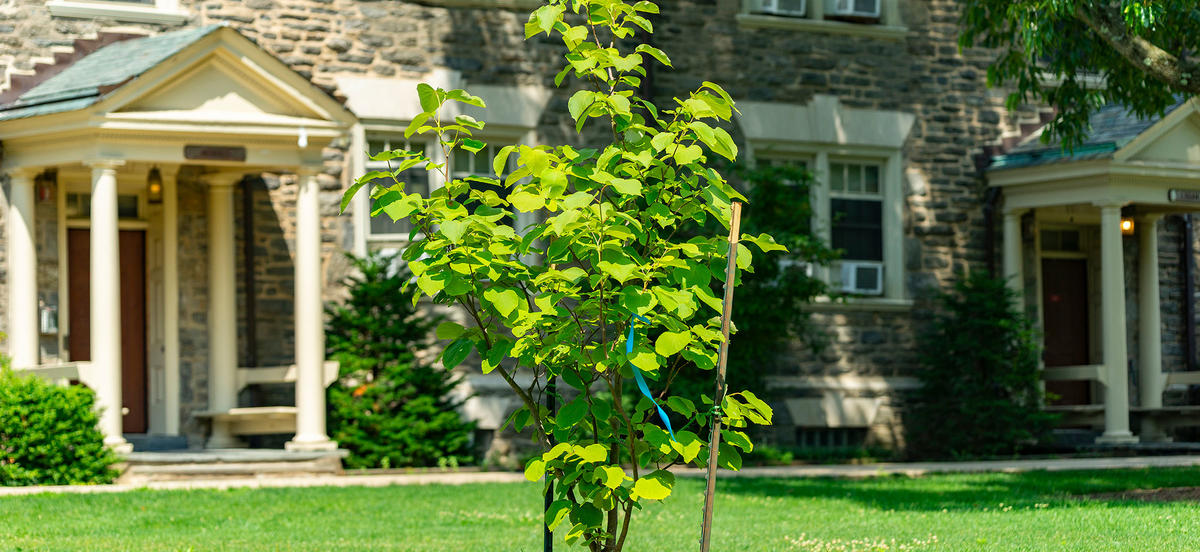With 1,000 Trees Planted, Haverford College Arboretum Achieves 10-Year Plan in 5

Details
When Sally Anderson interviewed for the job of Haverford College Arboretum Plant Curator in the winter of 2017, Director Claudia Kent didn’t beat around the bush—or more appropriately, the trees—about what the job would entail.
"We have to plant 1,000 trees in 10 years," Kent told her.
The school’s first-ever comprehensive tree assessment earlier that year had determined that nearly 500 of the 5,000 trees that make up the nation’s oldest college arboretum were either diseased, decayed or failing due to climate change, and would have to be removed. Concerned about how this might diminish or compromise a 216-acre collection of more than 400 species of trees and shrubs, a 10-year plan to plant two trees for each one uprooted was mapped, using a diverse palate more resilient than those replaced to ensure Haverford’s urban forest would be better prepared for the future.
An example, says Kent, is oak trees. At the time of the risk assessment, they represented 30% of the Arboretum collection. "The oak is actually on our logo; it's kind of a signature plant, but having 30% of anything is not a good idea," says Kent, "especially when that species has been prone to disease, which has been the case recently with oak," she adds.
"With oaks, and if it's 30% of our collection, we could lose a lot of our trees," Kent says. "So now we have a 'do not plant’ list."
The Arboretum’s planting policy was also tweaked. Anything planted in a natural area along the campus fringe must be native to the region. Of the new trees planted in the center part of campus, 70% must be native to the region (although cultivars are allowed), and 30% can be non-native.
What Kent, Anderson and the Arboretum staff could not have anticipated were the sizable obstacles that would impede their timeline and goal. The pandemic dramatically altered campus life in the spring of 2020 and curtailed certain activity for a while longer. Then the spotted lantern fly infested the Northeast like a locust plague, threatening both new growth and the existing 5,000 or so trees spread across campus—some of them as old as the school itself. And, of course, the earth continued to warm, affecting species like the once-thriving sugar maple.
"I think if you had asked me during COVID whether we would get to 1,000 [trees planted by this point], I would have said, `No, that's probably not happening,’" says Jennie Kelly, the Arboretum Program Director who joined Kent’s staff at the onset of the project.
But they did, in roughly half the time—a credit to the many hands of volunteers and to Haverford’s commitment to the project. Above all, it is a testament to the determination of the staff and horticulturists to press on amid the challenges.
"I feel like there were a lot of factors against getting to that goal," says Kelly. "With COVID and the shutdown, and also how hot and dry it has been and just how much watering is required for new trees being planted with our small staff. I think those were all factors against reaching the goal early. But people were pretty determined to keep up the pace."
Perhaps most determined was Kent, who has been part of Arboretum staff in one role or another for 22 years. Right from the start, she emphasized collaboration and project ownership, setting an annual planting goal of 15 trees for each member of her four-person staff. Contractors were hired too, and school and volunteer groups recruited and encouraged through Kelly’s outreach.
"All of the events and the programming that Jennie does with school students and with programs that we offer to the public has really brought a new dimension to the Arboretum," says Kent, who created the role of Program Director in 2017 with that in mind. "We've really upped our game, too, along the lines of design and planting trees. And that's where Sally has been important. We work together on a lot of different planting projects. So it feels like there's a lot more energy."
That's certainly apparent in the track record. There were 41 trees planted in 2017, 189 in 2018 and 369 in 2019. Despite the pandemic, 90 new trees were planted in 2020 and 147 in 2021, 72 in 2022 and 92 so far in 2023 (at the time of this writing).
That’s 1,000 trees, five years ahead of schedule.
The 1,000th tree planted, in front of Lloyd Hall in late May, was a Styrax obassia. Also called "Fragrant Snowbell," it is a small, slender, upright tree native to Japan that typically grows 20 to 30 feet tall and produces bell-shaped, fragrant white flowers in late spring. President Wendy Raymond joined staff to mark the occasion by grabbing a shovel and doing the literal dirty work.
It was the perfect punctuation to the overwhelming success of the project, says Anderson, the curator whose job is to log every tree in this ambitious Arboretum that was designed by English gardener William Carvill back in 1834. "I looked [that species] up and saw we had very few of them," she says. "One of my goals is to constantly keep an eye out for trees that we don't have or don’t have many of – so we can keep the variety going that has made this place so very special."
—Sam Donnellon



